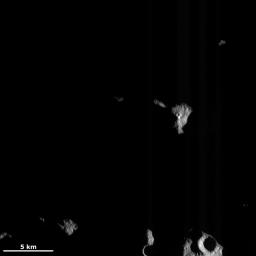This Dawn FC (framing camera) image shows a part of Vesta's northern hemisphere, which is mostly in darkness. Since Dawn's arrival at Vesta the sun has not illuminated Vesta's most northerly latitudes. This is because the tilt of Vesta with respect to the sun has not been suitable for illuminating these parts of the asteroid. But, as Vesta progresses from its winter to its spring more of these northerly latitudes are being illuminated. As seen in this image the illumination begins by the low-angled sun revealing a few higher elevation parts of the surface, while the rest of the lower-lying surface is still covered in darkness. More of this area will need to be illuminated for any meaningful interpretations of it to take place.
This image is located in Vesta's Bellicia quadrangle and the center of the image is 50.6 degrees north latitude, 40.7 degrees east longitude. NASA's Dawn spacecraft obtained this image with its framing camera on Nov. 19, 2011. This image was taken through the camera's clear filter. The distance to the surface of Vesta is 275 kilometers (171 miles) and the image has a resolution of about 25 meters (82 feet) per pixel. This image was acquired during the transfer to LAMO (low-altitude mapping orbit) phase of the mission.
The Dawn mission to Vesta and Ceres is managed by NASA's Jet Propulsion Laboratory, a division of the California Institute of Technology in Pasadena, for NASA's Science Mission Directorate, Washington D.C. UCLA is responsible for overall Dawn mission science. The Dawn framing cameras have been developed and built under the leadership of the Max Planck Institute for Solar System Research, Katlenburg-Lindau, Germany, with significant contributions by DLR German Aerospace Center, Institute of Planetary Research, Berlin, and in coordination with the Institute of Computer and Communication Network Engineering, Braunschweig. The Framing Camera project is funded by the Max Planck Society, DLR, and NASA/JPL.
More information about the Dawn mission is online at http://www.nasa.gov/dawn and http://dawn.jpl.nasa.gov.

 Planetary Data System
Planetary Data System












